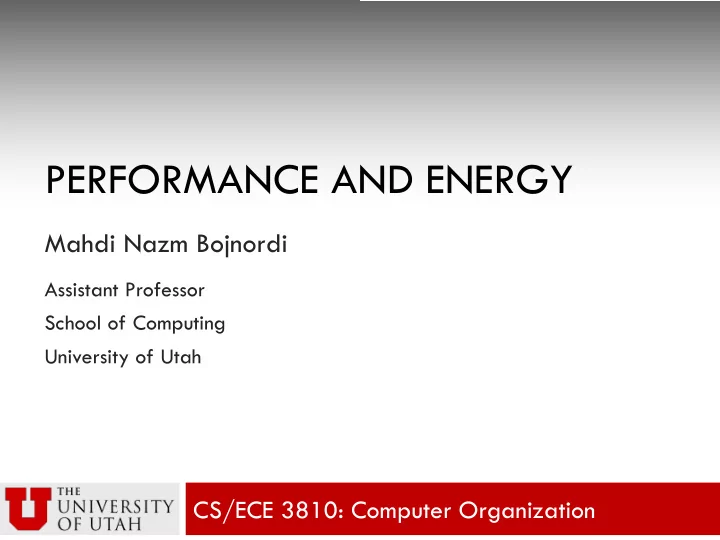

PERFORMANCE AND ENERGY Mahdi Nazm Bojnordi Assistant Professor School of Computing University of Utah CS/ECE 3810: Computer Organization
Overview ¨ Homework 1 due on Jan 17 th (midnight) ¨ TA office hours were posted ¤ One/two more TAs may be added ¨ This lecture ¤ Amdal’s Law ¤ Energy and power ¤ Instruction set architecture (ISA)
Recall: Principles of Comp. Design ¨ Designing better computer systems requires better utilization of resources ¤ Parallelism n Multiple units for executing partial or complete tasks ¤ Principle of locality (temporal and spatial) n Reuse data and functional units ¤ Common Case n Use additional resources to improve the common case n 10% of the program accounts for 90% of execution time (90-10 rule)
Amdahl’s Law ¨ The law of diminishing returns
Amdahl’s Law ¨ The law of diminishing returns
Amdahl’s Law ¨ The law of diminishing returns
Example Problem ¨ Our new processor is 10x faster on computation than the original processor. Assuming that the original processor is busy with computation 40% of the time and is waiting for IO 60% of the time, what is the overall speedup?
Example Problem ¨ Our new processor is 10x faster on computation than the original processor. Assuming that the original processor is busy with computation 40% of the time and is waiting for IO 60% of the time, what is the overall speedup? f=0.4 s=10 Speedup = 1 / (0.6 + 0.4/10) = 1/0.64 = 1.5625
CPI example ¨ Computer A: Cycle Time = 250ps, CPI = 2.0 ¨ Computer B: Cycle Time = 500ps, CPI = 1.2 ¨ Same ISA ¨ Which is faster, and by how much?
CPI example ¨ Computer A: Cycle Time = 250ps, CPI = 2.0 ¨ Computer B: Cycle Time = 500ps, CPI = 1.2 ¨ Same ISA ¨ Which is faster, and by how much? CPU Time A = Instruction Count × CPI A × Cycle Time A = I × 2.0 × 250ps= I × 500ps A is faster… CPU Time B = Instruction Count × CPI B × Cycle Time B = I × 1.2 × 500ps= I × 600ps CPU Time B = I × 600ps I × 500ps = 1.2 …by this much CPU Time A
Measuring Performance ¨ What program to use for measuring performance? ¨ Benchmarks Suites ¤ A set of representative programs that are likely relevant to the user ¤ Examples: n SPEC CPU 2006: CPU-oriented programs (for desktops) n SPECweb: throughput-oriented (for servers) n EEMBC: embedded processors/workloads
SPEC CPU Benchmark ¨ Programs used to measure performance ¤ Supposedly typical of actual workload ¨ Standard Performance Evaluation Corp (SPEC) ¤ Develops benchmarks for CPU, I/O, Web, … ¨ SPEC CPU2006 ¤ Elapsed time to execute a selection of programs n Negligible I/O, so focuses on CPU performance ¤ Normalize relative to reference machine ¤ Summarize as geometric mean of performance ratios n CINT2006 (integer) and CFP2006 (floating-point) 0 3 ! "#$%&'()* '(,$ -.'() / /12
Power and Energy ¨ Power = Voltage x Current (P = VI) ¤ Instantaneous rate of energy transfer (Watt) ¨ Energy = Power x Time (E = PT) ¤ The cost of performing a task (Joule)
Power and Energy ¨ Power = Voltage x Current (P = VI) ¤ Instantaneous rate of energy transfer (Watt) ¨ Energy = Power x Time (E = PT) ¤ The cost of performing a task (Joule)
Power and Energy ¨ Power = Voltage x Current (P = VI) ¤ Instantaneous rate of energy transfer (Watt) ¨ Energy = Power x Time (E = PT) ¤ The cost of performing a task (Joule) Peak Power = 3W Average Power = 1.66W Total Energy = 5J
CPU Power and Energy ¨ All consumed energy is converted to heat ¤ CPU power is the rate of heat generation ¤ Excessive peak power may result in burning the chip ¨ Static and dynamic energy components n Energy = (Power Static + Power Dynamic ) x Time n Power Static = Voltage x Current Static n Power Dynamic � Capacitance x Voltage 2 x (Activity x Frequency)
Recommend
More recommend